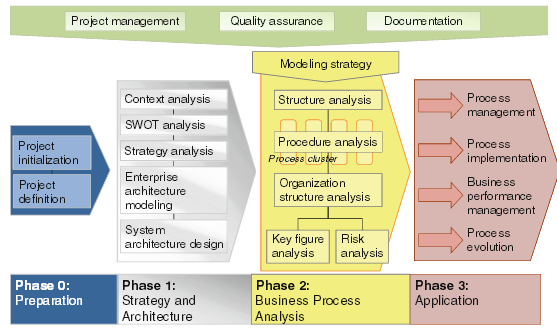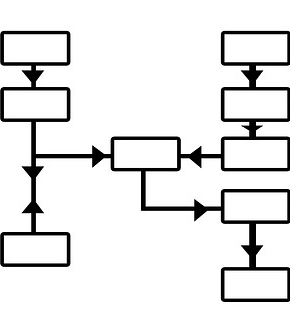Exam questions for the lecture “Business Processes for Business Communities“ (A. Oberweis / A. Koschmider)
Question 1: Please describe three model types of the HORUS process models? Please describe the intention of each model type.
Solution to question 2:
- Procedure Model/Business Process modeling: During process modeling, all processes of an enterprise or of the respective application area are recorded. These can be different types of processes, such as business-critical, administrative, or supporting processes. One may proceed, for example, from bottom to top (“bottom-up”), initially modeling individual activities, then gradually combining these into larger units (subprocesses and processes). One can also, and this will be our approach, proceed from top to bottom (“top-down”), first providing an initial overview of the highest level of abstraction at which the core business processes of the company are identified; these are then gradually refined.
- Organizational model: in organization modeling, the essential parts of the underlying organization are depicted, usually in the form of a hierarchy that includes the executive board as the highest level, followed by departments or areas such as purchasing, warehousing, product management, or sales.
- Object model: The objects and/or documents required by activities and processes are modeled in object modeling. Here, it is conceivable that a class diagram is created that describes, for example, in the notation of the Unified Modeling Language (UML), which object schemes or classes of a particular scope underlie which attributes and methods.
Question 2: Please describe the structure of the Horus Business Process Engineering Method.
Solution to question 3:
The Horus method looks at a process together with its organizational environment or context. In addition, this method motivates a user to describe all relevant aspects with exactly those techniques that are best suited for them. The Horus method offers steps both for model expansion through additional elements (activities, organization units, etc.) as well as for joining various modeling elements (e.g., organization unit is responsible for an activity or executes it). Horus subdivides business process engineering into four phases.
- Phase 0 is the preparation of the engineering project.
- Phase 1 is the strategy and architecture phase to study the strategic aspects and definition of enterprise and system architecture. Phase 2 is the detailed business process analysis.
- Phase 3 is the subsequent usage of the model. Beyond these phases, modeling is accompanied by project management, measures for quality assurance, and up-to-date documentation. Project definition creation takes place together with the initialization of the project during the preparation phase. This determines which parts of an organization will be examined—often called project scope —and what budget and time frames are available for this purpose. Project goals to be accomplished are additionally outlined and examined regarding their strategic and economic value, including a subsequent budget comparison.
- Phases 1 and 2 deal with the analysis and modeling of strategic aspects associated with the business and system architecture, as well as a detailed examination of the business processes. A special feature of the Petri nets used here is their simulation capability. In practice, simulation proves itself as an instrument for the dynamic analysis and testing of models “under load.” Simulation results can be visualized in a simple, understandable, and meaningful form by way of graphic animations.
Structure and steps of the Horus method:





